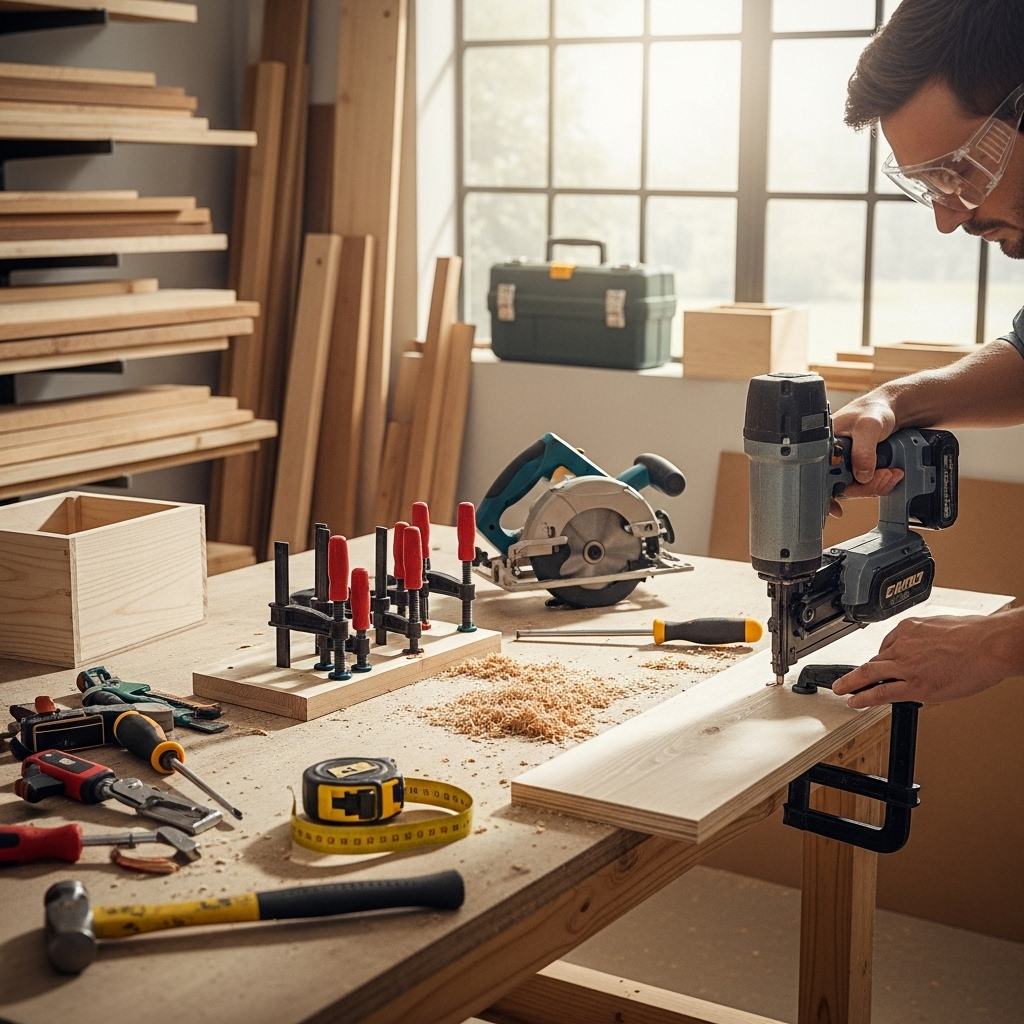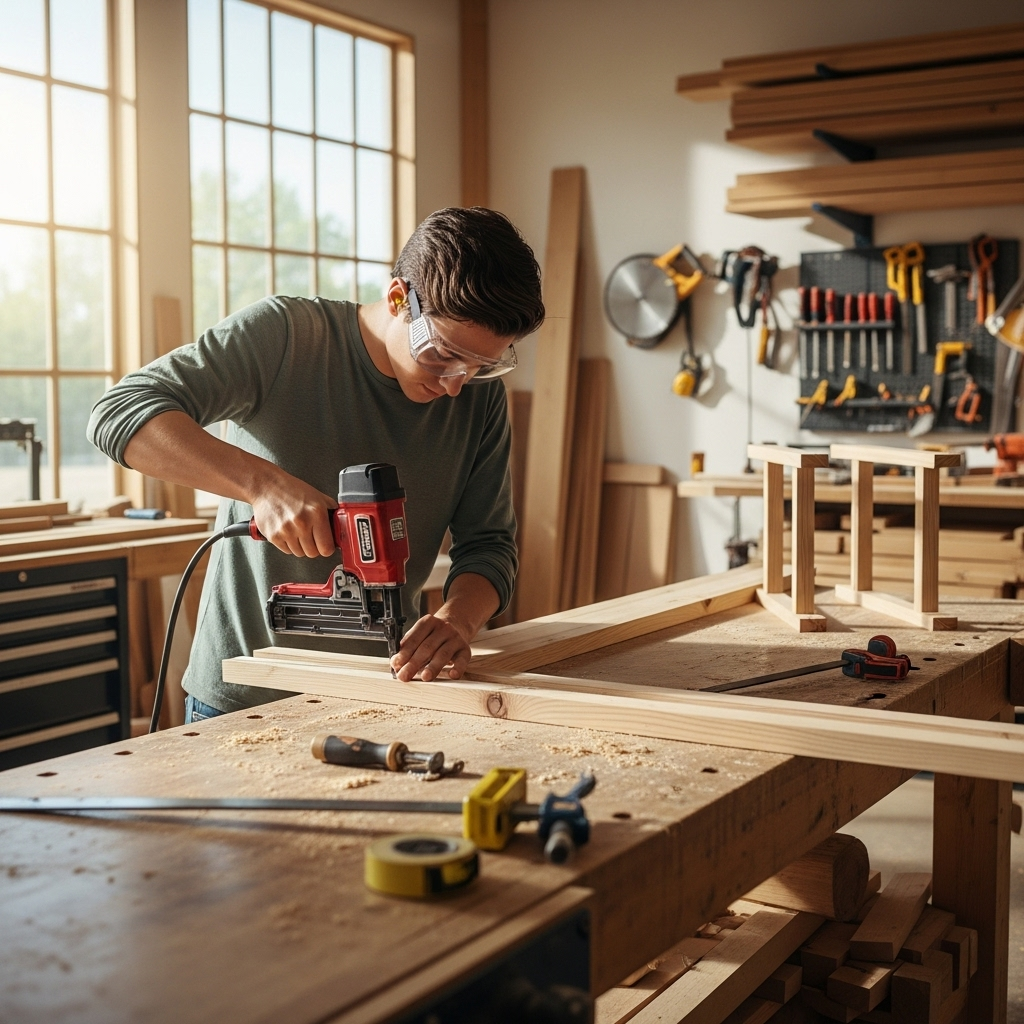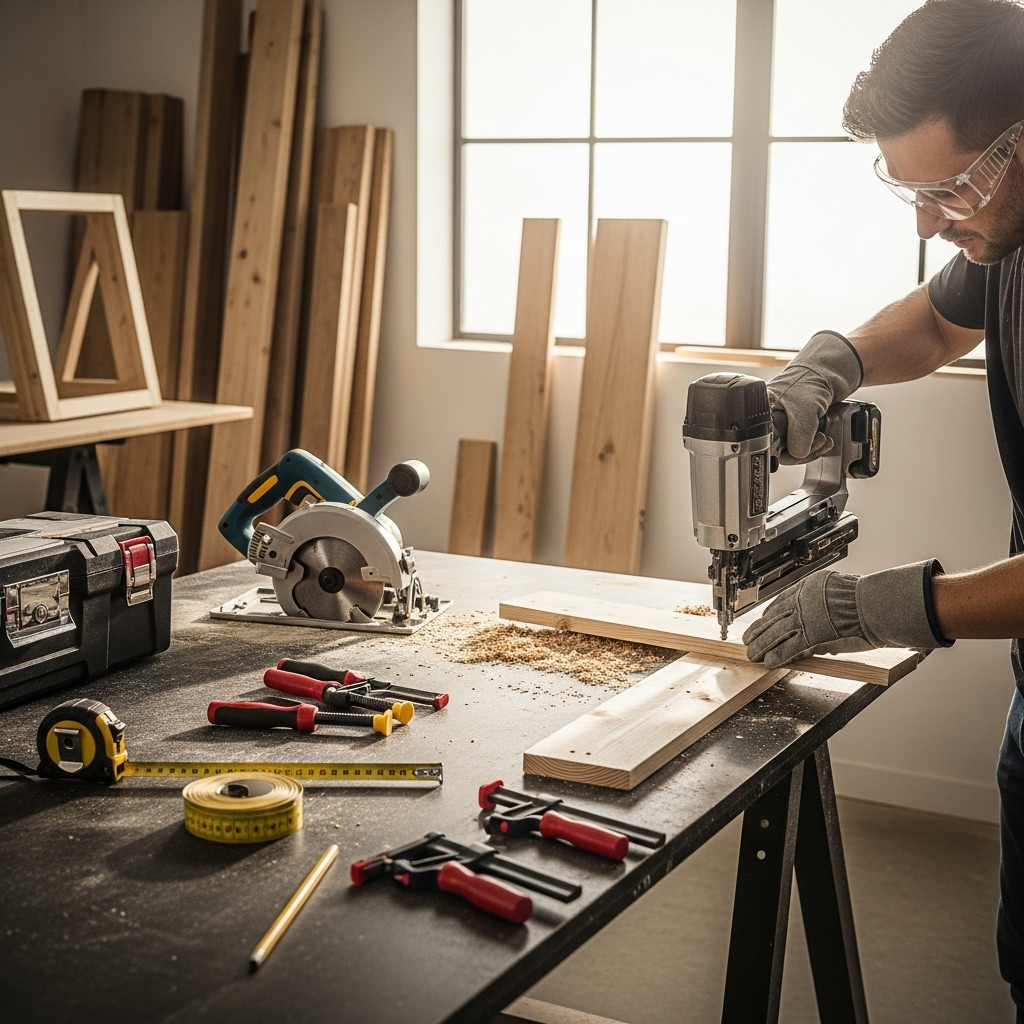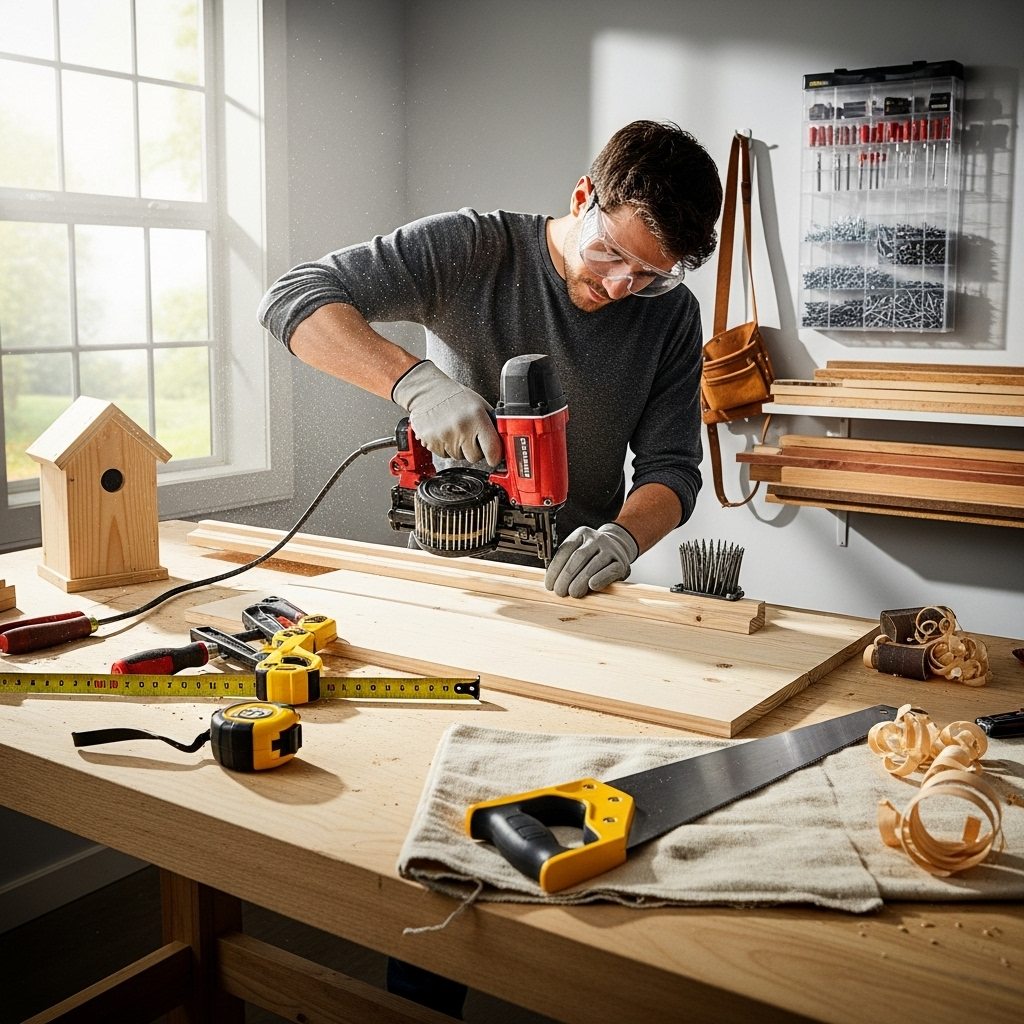Woodworking projects with modern geometric shapes can elevate your home decor with visually striking, contemporary designs. From simple wall art to functional furniture, incorporating clean lines and repeating patterns creates a sophisticated, DIY-friendly aesthetic that’s surprisingly achievable for beginners.
Feeling a bit uninspired by traditional home décor? Looking to add a fresh, modern touch to your living space without breaking the bank or needing a degree in carpentry? You’ve come to the right place! Many of us love the idea of crafting our own furniture or décor, but the thought of complex joinery or intricate designs can feel intimidating. The good news is, you don’t need to be a master craftsman to create stunning pieces. Modern geometric shapes in woodworking offer a fantastic entry point. They’re forgiving, visually impactful, and can be adapted to suit your skill level and style. Let’s explore how you can bring these sharp, clean designs into your home.
This guide is packed with genius ideas for woodworking projects featuring modern geometric shapes. We’ll cover everything from choosing your materials to simple project walkthroughs, making it easy for you to pick up your tools and start creating. Get ready to transform your space with some truly unique, handmade pieces!
Table of Contents
Why Modern Geometric Shapes in Woodworking?
Modern geometric woodworking is all about clean lines, repeating patterns, and forms that feel current and stylish. Think hexagons, triangles, squares, and even more complex polyhedrons. These shapes are popular in interior design for several reasons:
- Visual Appeal: Geometric patterns are inherently pleasing to the eye. They bring order and balance to a room.
- Versatility: Geometric designs can be incorporated into almost anything – from small decorative items to large furniture pieces.
- Beginner-Friendly: Many geometric shapes can be cut and assembled with basic tools and techniques. The precision required is often more about careful measuring and cutting than complex woodworking joints.
- Modern Aesthetic: They instantly update a space, giving it a fresh, contemporary feel that pairs well with minimalist or eclectic styles.
- Customization: You can play with different wood types, finishes, and sizes to match your décor perfectly.
Getting Started: Tools and Materials

Before we dive into specific projects, let’s talk about what you’ll need. Don’t let a long tool list scare you! Many of these projects can be tackled with just a few essential items. Safety first, always!
Essential Tools for Geometric Woodworking
For most projects involving geometric shapes, you’ll need tools that can make precise cuts. Here are some basics:
- Safety Gear: Absolutely non-negotiable! Safety glasses, hearing protection, and work gloves are a must.
- Measuring Tape & Pencil: For accurate marking.
- Wood Glue: The backbone of many woodworking joints.
- Clamps: Essential for holding pieces together while glue dries.
- Saw:
- Hand Saw: A basic option for smaller cuts, but requires more effort and precision.
- Miter Saw (Chop Saw): Your best friend for accurate angled cuts, perfect for geometric shapes. A sliding miter saw offers even more versatility.
- Circular Saw with a Guide: Good for larger cuts, and with a guide, can achieve good accuracy.
- Jigsaw: Useful for curved geometric shapes or cutouts, but less precise for straight lines.
- Sander: Orbital or belt sander for smoothing edges and surfaces. Sandpaper in various grits (e.g., 80, 120, 220) is also key.
- Drill/Driver: For pre-drilling holes and driving screws (if your design calls for them).
Choosing Your Wood
The type of wood you choose can significantly impact the look and feel of your project. For geometric projects, consider:
- Plywood: Affordable, stable, and comes in various types (birch, oak veneer). The exposed edge grain can look great in geometric patterns.
- Pine: Softwood, inexpensive, and easy to work with. Great for beginners. Can be easily painted or stained.
- Hardwoods (Oak, Maple, Walnut): More expensive and harder to work with, but offer a beautiful, durable finish. Excellent for statement pieces.
- Reclaimed Wood: Adds character and a rustic-modern feel. Ensure it’s clean and free of nails.
For many beginner geometric projects, standard pine boards or cabinet-grade plywood are excellent choices. They are forgiving and readily available at your local home improvement store.
Genius Woodworking Projects with Modern Geometric Shapes
Let’s get to the fun part! Here are some ideas, ranging from simple to slightly more involved, that showcase the beauty of geometric woodworking.
1. Geometric Wall Art (Hexagon, Triangle, or Diamond Panels)
This is a fantastic starting point for beginners. You can create dynamic wall art by combining multiple geometric shapes.
Project Idea: DIY Hexagon Wall Shelves
These look impressive but are surprisingly simple to build. Imagine a cluster of hexagons on your wall, perfect for displaying small plants or trinkets.
Materials:
- 1×6 or 1×8 Pine Boards (length depends on how many hexagons you want)
- Wood Glue
- Wood Screws (optional, for added strength)
- Sandpaper (120 & 220 grit)
- Wood Finish (stain, paint, polyurethane)
- Mounting hardware (D-rings or keyhole hangers)
Tools:
- Miter Saw (ideal for precise 30-degree cuts)
- Measuring Tape & Pencil
- Clamps
- Drill/Driver
- Sander
Steps:
- Cut Your Pieces: To create a hexagon, you need six equal-length pieces. The ends of each piece must be cut at a 30-degree angle. Ensure the angles are cut in opposite directions so they join to form the hexagon. For example, if you want a 10-inch wide hexagon, the longest point-to-point dimension would be roughly 10 inches, and each side piece would be approximately 5 inches long, measured along the longest edge. Double-check your measurements! A good online calculator can help determine exact side lengths for desired hexagon sizes.
- Dry Fit: Arrange your six pieces into a hexagon shape on your workbench. Ensure all the joints meet snugly.
- Glue and Clamp: Apply wood glue to the angled edges. Bring the pieces together and use clamps to hold them tightly. For extra strength, you can pre-drill pilot holes and add small wood screws.
- Let it Dry: Allow the glue to dry completely according to the manufacturer’s instructions.
- Sand: Once dry, sand all surfaces and edges until smooth. Start with 120 grit and finish with 220 grit.
- Finish: Apply your chosen wood stain, paint, or clear protective finish.
- Mount: Attach your chosen mounting hardware to the back of the hexagon. Hang them in a cluster for a dynamic display!
Tip: Vary the sizes of your hexagons for a more organic and visually interesting arrangement.
2. Geometric Coffee Table or Side Table Tops
Upgrade a plain table base or build a new one with a captivating geometric top. Parquet-style patterns or inlaid geometric designs can add a “wow” factor.
Project Idea: Simple Geometric Parquet Table Top
This involves cutting small pieces of wood and arranging them in a repeating geometric pattern to form the surface of your table.
Materials:
- Thin wood boards (e.g., 1/4 inch or 1/2 inch plywood, or thin hardwood strips) in complementary or contrasting colors/finishes.
- Plywood (3/4 inch) for the table base/substrate.
- Wood Glue.
- Sandpaper.
- Finishing oil or polyurethane.
Tools:
- Miter Saw or Table Saw (for precise cuts of small pieces).
- Measuring Tape & Pencil.
- Clamps.
- Sander.
- Optional: Router with a flush-trim bit (if creating a frame).
Steps:
- Design Your Pattern: Sketch out a repeating geometric pattern. Common choices include herringbone, chevrons, or a simple offset square within a square.
- Prepare the Base: Cut a piece of 3/4-inch plywood to the desired size and shape for your table top.
- Cut Your Pattern Pieces: Using your thin wood boards, cut many identically sized small pieces. For a herringbone pattern, you’ll cut small rectangles with 45-degree miters on each end. For a simple square pattern, cut small squares. Precision is key here.
- Lay Out the Pattern: Begin arranging your small pieces onto the plywood base according to your design. Work in sections.
- Glue and Press: Apply wood glue to the back of each small piece and press it onto the base. You can also apply glue to the edges of adjacent pieces for a tightly fitted look. Once a section is complete, you might place a flat board over it and weigh it down or clamp it to ensure good adhesion.
- Continue Until Complete: Work your way across the entire base until the pattern is finished.
- Sand: Once all glue is dry, very carefully sand the entire surface. Start with a coarser grit if needed to level any slightly raised pieces, then move to finer grits (120, then 220) for a perfectly smooth finish. Be careful not to sand through the thin pattern pieces. A random orbital sander is ideal.
- Edge Finishing (Optional): You can add a solid wood edge band around the plywood base using a router and flush-trim bit for a more polished look.
- Apply Finish: Coat the entire table top with your chosen finish. Multiple coats of polyurethane will provide excellent durability for a coffee table.
Tip: Using pre-finished wood veneers or laminate strips can simplify this project significantly.
3. Geometric Planters and Vases
Bring shape and style to your greenery with geometric planters. Cubes, prisms, and multifaceted designs are popular.
Project Idea: DIY Wooden Geometric Planter Box
A segmented cube or angled structure that holds a liner for soil.
Materials:
- 1×4 or 1×6 Pine Boards
- Wood Glue
- Wood Screws (short, e.g., 1-1/4 inch)
- Sandpaper
- Exterior wood sealant or paint
- Plastic liner or landscape fabric
Tools:
- Miter Saw (for angled cuts)
- Measuring Tape & Pencil
- Clamps
- Drill/Driver
- Sander
Steps:
- Determine Size: Decide the dimensions of your planter. For a simple cube, you’ll need 12 identical pieces.
- Cut Pieces: Cut your wood into 12 equal-length pieces. The ends of each piece will need to be cut at angles to form the corners. For a simple box with 90-degree corners, you’d cut square edges. For a more dynamic look, experiment with angled cuts (e.g., 45 degrees for an octagonal shape).
- Assemble Sides: Create four sides of your box first. Glue and screw the pieces together, pre-drilling pilot holes to prevent splitting. Use clamps to hold pieces firmly while screwing.
- Assemble the Box: Join the four sides together to form the box. Ensure corners are square (or at the intended angle).
- Add the Base: Cut a piece of wood to fit the bottom opening and attach it securely with glue and screws.
- Sand and Seal: Sand all surfaces smooth. Apply a good quality exterior sealant or paint to protect the wood from moisture and UV rays.
- Add Liner: Line the inside with plastic to prevent direct contact with soil and water, or use landscape fabric. Ensure there are drainage holes in the liner or planter base.
External Resource: For more on choosing outdoor finishes, check out the Forest Products Laboratory, part of the U.S. Forest Service, with extensive research on wood protection.
4. Geometric Lighting Fixtures (Pendants, Lampshades)
Wood can be surprisingly effective in creating modern geometric lampshades or pendant light coverings. Think latticed spheres, angular lampshades, or geometric sconces.
Project Idea: DIY Geometric Wood Pendant Light Box
A simple box-like structure with patterned cutouts to diffuse light.
Materials:
- Thin wood strips (e.g., 1/4 inch thick poplar or basswood)
- Wood glue
- Sandpaper
- Small hanging light kit (socket, cord, plug)
- Spray paint or wood finish
Tools:
- Miter Saw or Table Saw (for precise cuts)
- Measuring Tape & Pencil
- Small clamps or painter’s tape
- Drill
- Jigsaw (for cutting out geometric patterns)
- Sander
Steps:
- Design and Cut Frame: Decide on the size and shape of your pendant. A simple cube or open geometric frame can work well. Cut four equal pieces for the sides and potentially two for the top/bottom, depending on your design. Use a miter saw for clean, angled joints.
- Assemble Frame: Glue and clamp the frame pieces together. For small, thin pieces, painter’s tape can sometimes substitute for clamps.
- Cut Pattern: On thin wood or plywood cut to fit within your frame, use a jigsaw to cut out geometric patterns (e.g., a large hexagon, a series of triangles, starburst).
- Attach Patterned Panel: Glue and carefully clamp the patterned wood panel onto one side of the frame.
- Sand and Finish: Once dry, sand smooth. Apply a light coat of spray paint or a wood finish.
- Install Light Kit: Carefully drill a hole in the top of your fixture to thread the light kit cord through. Follow the manufacturer’s instructions for safely installing the socket and ensuring the cord is securely held.
Safety Note: Ensure all electrical components are installed by someone knowledgeable or consult a qualified electrician. Always use low-heat LED bulbs and ensure adequate ventilation.
5. Geometric Wooden Bowls and Trays
Segmented bowls or trays assembled from precisely cut triangular or trapezoidal pieces can create stunning visual effects, especially when using contrasting wood colors.
Project Idea: Segmented Wooden Tray
This involves gluing together many angled pieces to form a circular or polygonal tray.
Materials:
- Multiple wood species (e.g., cherry, maple, walnut) for contrast
- Wood glue
- Sandpaper (various grits)
- Danish oil or other food-safe finish (if using for serving)
Tools:
- Table Saw with a miter gauge (essential for accurate segmentation)
- Measuring Tape & Pencil
- Clamps (band clamp is very useful here)
- Sander
- Router (optional, for creating a base or lip)
Steps:
- Choose Your Segments: Decide on the number of segments and the angle required. For a 12-sided shape (dodecagon), you’ll need 30-degree angles (360 / 12 = 30). If you want a 24-segment bowl, each angle would be 15 degrees.
- Prepare Wood Strips: Cut your chosen wood species into consistent width strips. The width determines the height of your tray.
- Cut Segments: Using a table saw with an accurately set miter gauge or a tapering jig, cut each strip into the required number of segments at the precise angle. For instance, for a 12-segment ring, each segment would have two 15-degree cuts (to make a 30-degree corner) on opposite ends of a rectangular piece.
- Assemble Rings: Apply glue to the angled faces of your segments and assemble them into rings. Use a band clamp or strong tape to hold them together tightly while drying. You will likely need to build up the tray by assembling multiple rings.
- Stack and Glue Rings: Once individual rings are dry, glue them together to build the height of your tray.
- Shape and Sand: After the entire tray is assembled and the glue is dry, you’ll likely need to shape the exterior and interior. A lathe is ideal for round bowls, but for polygonal trays, you can use a sander or grinder with careful finishing. Sand progressively through grits from 80 up to 220 or higher for a smooth finish.
- Apply Finish: For serving trays, use a food-safe finish like Danish oil. For decorative pieces, a polyurethane or lacquer works well.
Learning Resources: Sites like Wood Magazine often have excellent detailed guides and videos on segmented turning and construction.
Choosing the Right Wood for Your Project

The material you select can dramatically change the final look and your building experience. Here’s a quick table to help you decide:
| Wood Type | Pros | Cons | Best For |
|---|---|---|---|
| Pine | Inexpensive, lightweight, easy to cut and shape, widely available. | Softer, prone to dents and scratches, can be knotty. | Beginner projects, painted items, simple wall art, basic frames. |
| Plywood (Birch, Oak Veneer) | Stable, strong, smooth surface, edges can be decorative, affordable. | Can splinter if not cut carefully, edges need finishing. | Table tops, shelves, boxes, wall panels. |
| Poplar | Relatively inexpensive, straight-grained, takes paint and stain well, harder than pine. | Can be prone to denting, not as visually interesting as hardwoods. | Painted geometric projects, frames, internal structures. |
| Hardwoods (Oak, Maple, Walnut) | Durable, beautiful grain patterns, excellent for statement pieces. | More expensive, harder to cut and work with, can be heavy. | High-end furniture tops, decorative bowls, intricate inlay. |
| Reclaimed Wood | Unique character, eco-friendly, rustic-modern aesthetic. | May contain nails/screws, requires careful inspection and preparation, can be uneven. | Wall art, accent pieces, rustic furniture elements. |
Tips for Precision and Success
Working with geometric shapes often requires a bit more precision than other woodworking tasks. Here are some tips to help you achieve crisp, clean results:
- Measure Twice, Cut Once: This old woodworking adage is crucial for geometric projects. Any small error can compound and throw off your entire design.
- Use a Sharp Blade: A dull saw blade will tear the wood and create rough edges, especially on plywood. Ensure your saw blade is sharp and appropriate for the wood you’re cutting.
- Practice Your Angles: If using a miter saw, practice cutting precise angles on scrap wood before starting your project pieces.
- Use a Stop Block: For making multiple identical cuts, a stop block on your saw is invaluable for ensuring consistent piece lengths.
- Pre-Drill Pilot Holes: Especially when screwing into hardwoods or near the edges of wood, pre-drilling pilot holes will prevent splitting.
- Don’t Rush Clamping and Gluing: Ensure pieces are perfectly aligned before clamping. Wipe away excess glue with a damp cloth immediately.
- Smooth Sanding is Key: Take your time with the sanding process. Start with a coarser grit to level any inconsistencies and move to finer grits for a smooth, professional finish.
Frequently Asked Questions (FAQ)

What is the easiest geometric shape to start with for woodworking projects?
Triangles and squares are generally the easiest geometric shapes to cut and assemble for beginners. They often involve straight cuts or simple 45/90-degree angles, making them forgiving.
Do I need a miter saw to make geometric woodworking projects?
While a miter saw makes precise angled cuts much easier and faster, it’s not strictly mandatory. You can achieve good results with a handsaw and a miter box, or a carefully guided circular saw for straight cuts. However, for complex polygons requiring precise angles, a miter saw is highly recommended.
How do I join geometric wood pieces together securely?
Wood glue combined with clamping is the primary method for strong joints. For added durability, especially in structurally important pieces, you can supplement glue with screws (pre-drilled) or brad nails.
What kind of wood is best for modern geometric designs?
For clear, crisp lines, woods with fine, straight grain like maple or birch are excellent. Plywood with a quality veneer also works very well. For a more industrial or modern look, painting pine or poplar in bold colors is a great option.
How can I finish geometric wood projects to make them look professional?
Achieving a smooth finish is key. Thorough sanding through progressively finer grits (up to 220 or 320) is essential. Applying a good quality clear coat like polyurethane, or opting for a smooth, even paint job, will give your projects a professional polish.
Can I create curved geometric shapes?
Absolutely! While straight-line geometry is common, you can also incorporate curves. This might involve using a jigsaw to cut arcs or employing steam bending techniques for more advanced curved geometric forms.
Unleash Your Inner Geometric Designer
See? Creating beautiful, modern geometric woodworking projects is well within your reach. Whether you’re drawn to the clean lines of a hexagon shelf, the intricate patterns of a wooden tray, or the simple elegance of a geometric planter, the possibilities are vast.
Remember to always prioritize safety, take your time with measurements and cuts, and enjoy the process of bringing your vision to life. These projects are not only a fantastic way to display your creativity and skill but also to craft unique pieces that will add character and style to your home. So, gather your tools, pick out your favorite wood, and start building. You might be surprised at what you can create!
